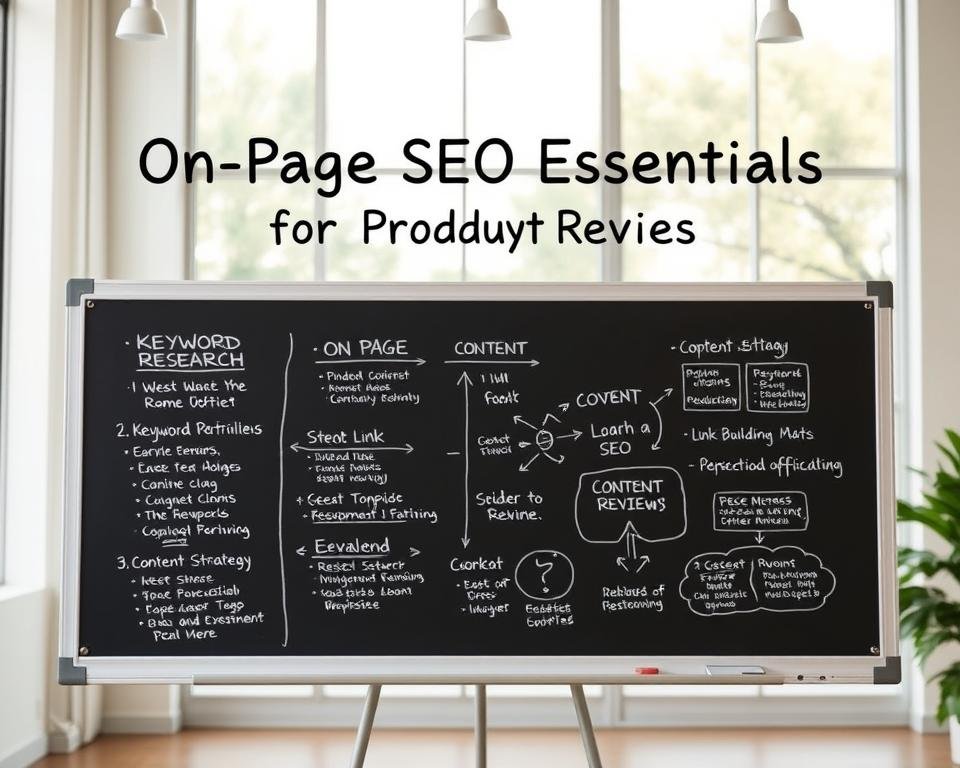As an affiliate marketer, having a well-optimized blog is key. It helps rank product review posts and boosts online income. I’ll show you how to use SEO strategies for affiliate marketing to get more traffic.
With the right methods, you can increase your affiliate earnings. Good SEO makes your product review posts seen by your audience.
Key Takeaways
- Understand the importance of SEO for affiliate blogs
- Learn how to optimize product review posts
- Discover strategies to improve search engine rankings
- Increase online income through effective SEO techniques
- Establish a successful affiliate marketing business
Understanding SEO Basics for Affiliate Blogging
To succeed in affiliate marketing, knowing SEO basics is key. It helps me optimize my blog, get more visitors, and earn more from my affiliate links. Understanding SEO has been a big help for me.
What is SEO and Why is it Important?
SEO stands for Search Engine Optimization. It makes your website more visible in search results. This is important because a higher ranking means more people see your site. As an affiliate marketer, I need my content to be search engine friendly to earn more commissions.
Key benefits of SEO for affiliate marketers include:
- Increased website visibility
- Targeted traffic to affiliate links
- Improved brand credibility
- Higher conversion rates
Key SEO Terms You Should Know
Knowing key SEO terms is vital for affiliate marketing. Terms like keyword density, meta tags, and backlinks are important for optimizing your content. These terms help you talk to your audience and search engines better.
The Role of Keywords in Affiliate Marketing
Keywords are very important in affiliate marketing. They help your content rank higher in search results. By using the right keywords, you can attract more visitors to your site. I use Google Keyword Planner to find the best keywords for my niche.
Effective keyword strategies include:
- Conducting thorough keyword research
- Using long-tail keywords to target specific search queries
- Optimizing your content with relevant keywords
Finding the Right Keywords for Your Niche
Keyword research is key for affiliate marketers. It finds the terms people use to look for products or services in your niche.
To begin, use special tools for keyword research. These tools find good keywords, check competition, and suggest more to get more visitors.
Tools for Keyword Research
Many tools help with keyword research. Each tool has its own special features and insights.
- Ahrefs: Known for its big keyword database and checking competitors.
- SEMrush: Does technical SEO checks, keyword research, and competitor analysis.
- Moz Keyword Explorer: Gives keyword ideas, search volume, and competitor info.
With these tools, you can make a list of keywords for your niche.
| Tool | Key Features | Usefulness for Affiliate Bloggers |
|---|---|---|
| Ahrefs | Keyword database, competitor analysis | High |
| SEMrush | Technical SEO audits, keyword research | High |
| Moz Keyword Explorer | Keyword suggestions, search volume data | Medium |
Long-Tail vs. Short-Tail Keywords
It’s important to know the difference between long-tail and short-tail keywords. This helps make your content better.
Short-tail keywords are short and general. They have a lot of searches but lots of competition too. Long-tail keywords are more specific. They have fewer searches but less competition.
“Fitness equipment” is a short-tail keyword. “Best home gym equipment for beginners” is a long-tail keyword. Going for long-tail keywords can be better for affiliate bloggers.

Analyzing Competitor Keywords
Looking at your competitors’ keywords can give you good ideas. It shows what works in your niche.
By seeing what keywords your competitors use, you can find gaps in your strategy. You can also find chances to beat them.
Tools like Ahrefs and SEMrush let you check your competitors. They show you their keyword plans. This helps you improve your own strategy.
On-Page SEO Essentials for Product Reviews
Affiliate marketers can boost their product review posts’ rankings with good on-page SEO. On-page SEO makes web pages rank higher and get more relevant traffic. It helps search engines understand the content and context of the page.
Optimizing Title Tags and Meta Descriptions is key. The title tag should be descriptive and include the main keyword. It should also be enticing to get clicks. For example, “Best Wireless Headphones Review: Top 5 Picks for 2023” is clear and includes keywords.
Title Tags and Meta Descriptions
Making title tags and meta descriptions engaging is important. Title tags should be under 60 characters to fit in search results. Meta descriptions should be 155-160 characters, giving a clear summary with target keywords.
A good meta description is “Discover our in-depth review of the best wireless headphones in 2023. We compare top models, features, and prices to help you make an informed purchase.” It summarizes the content well and includes keywords.
Importance of Headers and Subheaders
Headers and subheaders (H1, H2, H3, etc.) are vital for organizing content. They make the content easier to read and help search engines understand the page’s structure. The H1 tag is for the post title, and H2 and H3 tags for subsections.
Using headers like “Key Features to Consider” and “Comparison of Top Models” helps organize the content. It highlights important points in the product review.
Image Optimization Techniques
Images are key in product reviews, adding visual context and engaging users. Optimizing images means using descriptive file names and alt tags with target keywords. For example, “best-wireless-headphones-2023.jpg” with an alt tag “Best wireless headphones 2023 review” is optimized.

By using these on-page SEO tips, affiliate marketers can make their product review posts more visible. This can lead to more traffic and conversions.
Creating High-Quality Content that Converts
A successful affiliate blog needs content that informs and converts. As an affiliate marketer, your goal is to get people to click on your links and buy. You must create engaging, informative content that speaks to your readers.

Writing Engaging and Informative Reviews
Writing detailed product reviews is key to quality content. It’s important to give a balanced view of the product. Share your own experiences to make it relatable.
Include these elements in your reviews:
- Detailed product descriptions
- Pros and cons of the product
- Comparison with similar products
- Personal experience with the product
Incorporating User-Generated Content
Adding user-generated content (UGC) boosts your content’s quality. UGC includes customer reviews and testimonials. It helps build trust and credibility with your audience.
To get more UGC, try these:
- Ask readers to leave comments and reviews
- Respond to comments and engage with your audience
- Use social media to share UGC
Utilizing Storytelling in Reviews
Storytelling makes your content memorable and engaging. It helps create an emotional bond with your audience. This increases the chance of them clicking on your affiliate links.
Here are tips for storytelling in reviews:
- Use narratives to describe your personal experience with the product
- Create a scenario that shows the product’s benefits
- Highlight the problems the product solves
Building Effective Internal and External Links
To make your affiliate blog better, focus on both internal and external links. A good linking plan helps your site’s SEO. It makes your site easy for users and search engines to navigate.
The Power of Internal Linking Strategies
Internal linking helps search engines see your site’s layout and content order. It makes your blog easier to use and keeps visitors interested in more of your content.
Best practices for internal linking include:
- Linking to relevant and related content
- Using descriptive anchor text
- Avoiding over-linking, which can dilute the importance of your links

Finding Quality External Links
External linking adds credibility to your blog. It’s key to link to high-quality, relevant sources that add value to your readers.
When finding external links, consider the following:
- Relevance: Ensure the linked content is relevant to your topic
- Authority: Link to authoritative sites with a good reputation
- Diversity: Link to a variety of sources to provide a complete view
Link Building Techniques
Link building is vital for SEO. It involves getting hyperlinks from other sites to yours. Good link building boosts your site’s visibility, drives traffic, and improves rankings.
Some effective link building techniques include:
- Guest blogging on reputable sites
- Creating high-quality, linkable content
- Participating in online communities related to your niche
By using these strategies, you can boost your affiliate blog’s SEO. This improves your online presence.
Technical SEO Considerations
To do well in affiliate marketing, knowing technical SEO is key. It helps your blog get seen by search engines and users. This makes your blog easy to find and use.
Mobile Optimization Best Practices
Most people use mobile devices to surf the web. Making your blog mobile-friendly is a must. It boosts user experience and search rankings.
- Use responsive design to adapt to different screen sizes.
- Optimize images and leverage browser caching to improve page load times.
- Ensure that content is easily readable on smaller screens.

Improving Site Speed
Site speed matters a lot for rankings. It affects how users feel and how search engines see your site. Here’s how to make your site faster:
- Optimize images by compressing them without losing quality.
- Minify CSS, JavaScript, and HTML to reduce file sizes.
- Leverage browser caching to store frequently-used resources.
These steps will make your site run smoother and please your visitors more.
SSL Certificates and Security
SSL certificates are good for rankings and trust. They keep data safe between your site and users. This makes browsing safer.
Key benefits of SSL certificates include:
- Enhanced security for user data.
- Improved trust and credibility with your audience.
- A slight boost in search engine rankings.
By focusing on these technical SEO areas, you can make your blog more visible and successful. This means more visitors and more money.
Crafting an Effective Affiliate Disclosure
As an affiliate marketer, it’s key to be open and clear with your audience. This builds trust and meets legal needs. It also makes your readers happy.
Legal Requirements for Affiliate Links
The Federal Trade Commission (FTC) says you must tell people when you use affiliate links. This is to be honest with your readers.
To follow FTC rules, your disclosure should be:
- Clear: Use simple words that everyone can get.
- Conspicuous: Make sure it’s easy to see and not hidden.
- Proximate: Put your disclosure close to the link so it’s clear.
Best Practices for Transparency
Being open is more than just following the law. It’s about being trusted. Here are some tips:
| Best Practice | Description |
|---|---|
| Clear Language | Use simple words to explain your connection. |
| Prominent Placement | Put your disclosure where it can’t be missed. |
| Regular Updates | Update your disclosure when your affiliations change. |
Engaging Readers with Disclosures
A good disclosure can make your readers feel closer to you. Being open shows you care about their trust.
Here are some ways to connect with your readers:
- Tell them why you use affiliate links.
- Be honest about the good and bad of what you promote.
- Speak in a friendly way in your disclosure.

By following these tips, you can make a great affiliate disclosure. It will meet legal needs and make your audience feel closer to you.
Leveraging Social Media for SEO
I’ve found that a good social media plan can really help my SEO. It brings more visitors to my site and makes me more visible online.
Social media is key for promoting my blog and boosting my SEO. It helps me connect with more people and get more readers.
Platforms to Promote Affiliate Blogs
I choose the best social media sites to share my blog. These are:
- Facebook: It’s great for sharing and talking to my audience.
- Instagram: Its focus on pictures helps me share interesting content.
- Twitter: It’s perfect for quick updates and chatting with followers.
- Pinterest: Ideal for sharing product reviews and links.
Creating Shareable Content
To get more shares, I make sure my content is top-notch. I focus on:
- Informative Posts: Sharing useful info keeps my audience coming back.
- Visually Appealing Graphics: Good pictures make my content more shareable.
- Compelling Headlines: Catchy headlines help get more shares.

Using Hashtags and Trends
To get my content seen more, I use the right hashtags and follow trends. This means:
- Researching Popular Hashtags: Using well-known hashtags helps more people find my content.
- Participating in Trending Conversations: Joining in on popular topics keeps me relevant and attracts new followers.
- Creating Branded Hashtags: My own hashtags help build a community around my blog.
By using these social media tips, I can boost my SEO and grow my online presence.
Measuring SEO Performance
It’s key to know how well your SEO is doing. This helps you see what’s working and what’s not. By looking at important metrics, you can make your SEO better.
Understanding Google Analytics
Google Analytics is a great tool for website insights. It shows you traffic, engagement, and how many people are converting. To use it well, you need to know its main parts and how to read the data.
Key Features of Google Analytics:
- Traffic analysis: See where visitors come from and how they interact with your site.
- Conversion tracking: Watch what actions visitors take, like filling out forms or buying things.
- Audience insights: Find out about your visitors’ demographics, interests, and habits.
Key Metrics to Track
To really measure your SEO, you need to watch certain metrics. Here are some important ones:
| Metric | Description | Importance |
|---|---|---|
| Organic Traffic | The number of visitors from search engines. | High |
| Keyword Rankings | Your target keywords’ position in search results. | High |
| Conversion Rate | The percentage of visitors who take action. | High |
Adjusting Your Strategy Based on Data
After you’ve looked at your SEO data, you can tweak your plan. This might mean changing your keywords, improving your content, or making your site easier to use.
By keeping an eye on your SEO and making changes, you can do better with your affiliate blogging. This will help you get better results.
Staying Updated with SEO Trends
SEO is always changing. Keeping up with the latest trends is key for affiliate blogs to succeed. Search engine algorithms and ranking factors change often. So, affiliate marketers must stay informed.
To keep up, following industry leaders and blogs is important. Moz, Ahrefs, and SEMrush are great sources. They share the latest SEO tips and trends.
Following Industry Leaders and Blogs
Following leaders and blogs helps you stay current. You learn new techniques and strategies. This can boost your blog’s search engine ranking.
- Moz: Known for their SEO and digital marketing guides.
- Ahrefs: Offers tools for keyword research, link building, and content analysis.
- SEMrush: Provides insights on technical SEO, competitor analysis, and content optimization.
Importance of Continuous Learning
Learning never stops in SEO. Staying current with trends and best practices is essential. This helps refine your strategies and improve your blog’s performance.
Ways to keep learning include webinars, online forums, and courses. These help you stay ahead and adapt to algorithm changes.
| Learning Resource | Description | Benefits |
|---|---|---|
| Webinars | Online sessions on specific SEO topics | Gain insights from experts, ask questions |
| Online Forums | Discussion platforms for SEO professionals | Share knowledge, stay updated on discussions |
| Online Courses | Structured learning programs on SEO and digital marketing | Comprehensive knowledge, certification |
Adapting to Algorithm Changes
Search engine algorithms change often. Adapting to these changes is vital for your blog’s visibility. Staying informed about updates helps adjust your strategies for success.
Key areas to focus on include:
- Content quality and relevance
- User experience and engagement metrics
- Technical SEO and site performance
By focusing on these, your blog can better handle algorithm changes. This keeps your online presence strong.
Building a Community Around Your Blog
As an affiliate blogger, creating a community around your blog is key. It brings back visitors and boosts your earnings. A loyal group supports each other, leading to more engagement and sales.
Engaging with Readers through Comments
Engaging with readers through comments is a great way to build a community. By replying to comments, you show you care about what they say. This encourages more talk and helps your blog grow.
- Respond quickly to comments to keep the conversation alive.
- Ask questions in your posts to spark discussions.
- Use comments to share more insights and value.
Using Email Marketing
Email marketing is a strong tool for growing your community. By collecting emails, you can share new content and updates. Good email marketing means personalizing messages, segmenting your list, and sending regular newsletters.
To start with email marketing, think about these steps:
- Offer something special, like a free eBook, to get people to sign up.
- Use tools to make your emails feel personal.
- Split your list to send the right content to the right people.
Creating a Newsletter for Updates
A newsletter is a smart way to share the latest with your community. Make sure it’s valuable to your readers. Include:
- Links to your newest blog posts and reviews.
- Special deals and offers.
- News and insights from the industry.
By using these methods, you can grow a dedicated community around your blog. This leads to more engagement, loyalty, and higher affiliate earnings.
Conclusion: Your Path to SEO Success
Using the right SEO strategies is key for your affiliate blog’s success. Follow the tips in this article to boost your online presence and earnings.
Key Takeaways
Good SEO for Affiliate Blogs means knowing the basics, picking the right keywords, and making quality content. It’s also important to link well, optimize your site, and use social media to promote your blog.
Adapting to Change
To succeed in affiliate marketing SEO long-term, keep up with new SEO trends and algorithm changes. This means always learning and updating your blog SEO strategies as needed.
Final Steps
Stay dedicated to your SEO work and try out different blog SEO strategies. Focus on making valuable content and connecting with your audience to get the best results.
